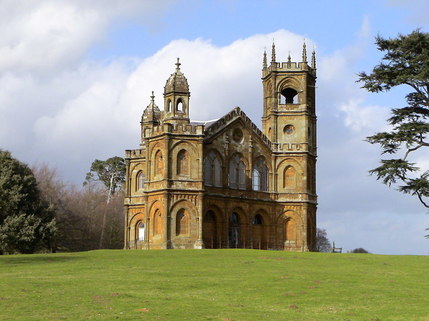|
If you were to travel back in time to the late 17th century to visit one of the grand estates in Britain, you would probably find it surrounded with beautiful, symmetrical gardens, accurately laid out in pleasing designs, where nature was strictly regulated and visibly tamed by man. But soon, tastes were changing, and in the early 18th century one man revolutionized British garden architecture by creating gardens that were modelled on paintings of an idealized landscape. This man was William Kent, and he invented what become known as the British landscape garden. His first garden project was Chiswick, where he worked largely under the guidance of his patron Lord Burlington. It was his next projects, among them Stowe and Stourhead, where he could fully develop his vision for this new style of garden. He designed the garden of Stowe House as an idyllic landscape with hills and valleys. A small river leisurely meanders through it, and small temples draw the eye and form focal points for beautiful vistas. Just like a landscape painter, the garden architect designs views and landscapes. Kent's ideas for garden design soon spread, not the least because of the men he was working with at Stowe, namely James Gibbs and Lancelot "Capability" Brown, who would become the greatest of all British garden architects and whose 300th birthday we celebrate this year. One of the intriguing things about landscape gardens are certainly the small buildings – the follies – dotted around the landscape. They reflect contemporary tastes, but can also be wildly eccentric. At Stowe we find neoclassical designs such as the Temple of Concord and Victory… …or the Rotunda… …next to some of the very first neo-gothic buildings in Britain, such as Gibbs' Gothic Temple… …and even the very first building in Britain built in the Chinese style. The garden at Stowe House was thus very much a forerunner in fashions of design: both chinoiserie and neo-gothic design would grow in popularity throughout the 18th century. Indeed, some people even put fake ruins into their gardens. A good example of this is the ruined castle built on the orders of the 1st Earl of Harwick in the gardens of Wimpole Hall. Yet the large parks and gardens were not merely meant for pleasure, but also had to serve a practical function: they had to provide fruits and vegetables for the kitchen of the country house. So as not to ruin the beautiful views, the kitchen gardens were usually built a little away from the house and were sometimes additionally shielded by trees. They were surrounded by high brick walls that served both as a protection from the wind and as a natural heat storage so even delicate plants like peach trees could prosper. On some estates, the kitchen gardens were integrated into the whole design of the grounds, and the hothouses in particular became lavish buildings which any owner would be proud to show to his guests. One of the plants cultivated in hothouses was the pineapple, which ideally would be ripe in time for Christmas. The 4th Earl of Dunmore seems to have had a particular liking for pineapples – a preference that is reflected in the very design of one of his large hothouses: the Dunmore Pineapple. Find out more: William Kent: Designing Georgian Britain https://www.youtube.com/watch?v=K99dalOrR1c Alan Titchmarsh gets a chance to look at Capability Brown's plans for the park and gardens of Belvoir Castle (pronounced "Beaver" Castle) – and they're pretty big: https://www.youtube.com/watch?v=Gd7hglXqtic Capability Brown's EPIC engineering: A look at the artifical lakes at Wotton House https://www.youtube.com/watch?v=O0fsB5cSaUQ And if you really, really, REALLY want to dig into garden history, check out the Garden History Lecture series organized by Claremont Fan Court School: Lecture 1: Subverting the Palladian: William Kent and the Eclectic Urge https://www.youtube.com/watch?v=hWxAaxUNnB8 Lecture 2: The Omnipotent Magician: Lancelot "Capability" Brown https://www.youtube.com/watch?v=iEsWWiYW8gE Attributions of Images
Stowe: Grecian Valley Looking towards the Temple of Concord and Victory: By Philip Halling, CC BY-SA 2.0, https://commons.wikimedia.org/w/index.php?curid=13521107 Stowe: The Rotondo from across the Eleven Acre Lake: By Philip Halling, CC BY-SA 2.0, https://commons.wikimedia.org/w/index.php?curid=4391378 Gothic Temple, Stowe: By Amanda Lewis, CC BY-SA 2.0, https://commons.wikimedia.org/w/index.php?curid=4391286 Stowe: The Chinese House: By Philip Halling, CC BY-SA 2.0, https://commons.wikimedia.org/w/index.php?curid=8397611 The Wimpole Folly: By Users Tysto, Nickarse2412 on en.wikipedia - Own work, CC BY-SA 3.0, https://commons.wikimedia.org/w/index.php?curid=1076760 The Dunmore Pineapple: By giannandrea - Own work, CC0, https://commons.wikimedia.org/w/index.php?curid=12863790
0 Comments
|
FOLLOW ME ON:
My Latest Release!
Duke of Shadows
A heartbroken belle, a missing suitor, and a heroic duke in disguise. Archives
April 2020
|
Privacy Policy
Cookies Policy
Terms of Service










 RSS Feed
RSS Feed
